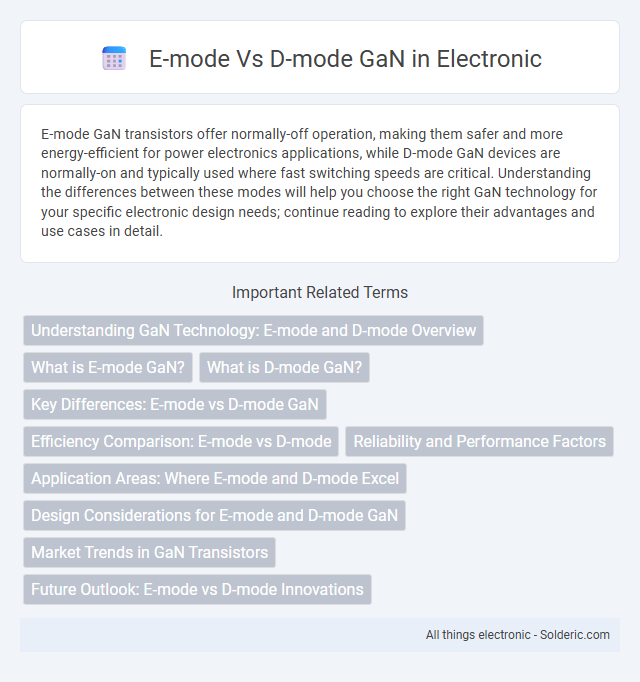E-mode GaN transistors offer normally-off operation, making them safer and more energy-efficient for power electronics applications, while D-mode GaN devices are normally-on and typically used where fast switching speeds are critical. Understanding the differences between these modes will help you choose the right GaN technology for your specific electronic design needs; continue reading to explore their advantages and use cases in detail.
Comparison Table
| Feature | E-mode GaN (Enhancement Mode) | D-mode GaN (Depletion Mode) |
|---|---|---|
| Default State | Normally Off | Normally On |
| Gate Threshold Voltage (Vth) | Positive (Vth > 0V) | Negative or zero (Vth <= 0V) |
| Switching Behavior | Turns on when gate voltage exceeds Vth | Conducts at zero gate bias, turns off with negative gate voltage |
| Applications | Power conversion, low power consumption circuits | Power amplifiers, RF circuits, level shifters |
| Safety | Fails safe (normally off) | May conduct uncontrollably if gate voltage is lost |
| Complexity | More complex fabrication due to gate engineering | Simpler structure, mature technology |
| Power Efficiency | Higher efficiency due to zero off-state current | Lower efficiency due to leakage current in off state |
Understanding GaN Technology: E-mode and D-mode Overview
E-mode (enhancement-mode) GaN transistors operate normally off and require a positive gate voltage to conduct, making them ideal for power-efficient switching applications. D-mode (depletion-mode) GaN transistors are normally on and turn off when a negative gate voltage is applied, often used in high-frequency and RF circuits. The choice between E-mode and D-mode GaN technology impacts device design, switching speed, and power efficiency across automotive, telecom, and industrial systems.
What is E-mode GaN?
E-mode GaN (Enhancement-mode Gallium Nitride) is a type of GaN transistor that remains off at zero gate voltage and requires a positive gate voltage to turn on, making it suitable for power electronics with fail-safe operation. E-mode GaN devices offer high electron mobility, low on-resistance, and fast switching speeds, significantly improving energy efficiency in applications such as power converters and RF amplifiers. Compared to D-mode GaN, which is normally-on, E-mode GaN enhances system reliability by preventing unintended conduction and simplifies circuit design by eliminating the need for negative gate drive voltages.
What is D-mode GaN?
D-mode GaN (Depletion-mode Gallium Nitride) transistors are normally-on devices that conduct current without an applied gate voltage, requiring a negative gate voltage to turn off the channel. These transistors are widely used in high-frequency and high-power applications due to their fast switching speeds and high electron mobility. D-mode GaN offers advantages in efficiency and thermal performance over traditional silicon devices, making it ideal for power amplifiers and RF circuits.
Key Differences: E-mode vs D-mode GaN
E-mode (Enhancement-mode) GaN transistors are normally off devices requiring a positive gate voltage to conduct, offering safer default states and simplified gate drive circuits, while D-mode (Depletion-mode) GaN transistors are normally on and conduct at zero gate voltage, needing a negative voltage to turn off. E-mode GaN devices exhibit higher gate threshold voltages, ideal for power-efficient switching, whereas D-mode devices provide lower on-resistance and faster switching speeds, commonly used in high-frequency applications. The choice between E-mode and D-mode GaN depends on the system design constraints, including fail-safe requirements and complexity of driving circuitry.
Efficiency Comparison: E-mode vs D-mode
E-mode GaN transistors offer improved safety and simpler gate drive requirements due to their normally-off operation, enhancing efficiency in low-voltage applications. D-mode GaN devices, though normally-on, provide lower on-resistance and faster switching speeds, making them more efficient in high-power, high-frequency scenarios. Your choice between E-mode and D-mode GaN should consider the balance between ease of use and maximum efficiency depending on the specific application needs.
Reliability and Performance Factors
E-mode GaN transistors offer enhanced reliability due to their normally-off operation, minimizing leakage currents and improving safety in power applications. D-mode GaN devices exhibit superior performance with lower on-resistance and faster switching speeds but require additional circuitry for safe operation. Your choice between E-mode and D-mode GaN will depend on balancing performance needs with long-term device stability and system complexity.
Application Areas: Where E-mode and D-mode Excel
E-mode GaN transistors excel in power electronics for automotive and renewable energy systems, enabling efficient, low-voltage switching crucial for electric vehicles and solar inverters. D-mode GaN devices dominate RF amplifiers and high-frequency applications, offering superior linearity and power density ideal for 5G base stations and radar systems. Both modes complement each other in hybrid power stages, optimizing performance across diverse industrial and communication technologies.
Design Considerations for E-mode and D-mode GaN
E-mode (Enhancement-mode) GaN transistors require a positive gate voltage to turn on, making them ideal for fail-safe power designs where the device remains off at zero gate bias, reducing risk of accidental conduction. D-mode (Depletion-mode) GaN devices are normally-on, conducting at zero gate voltage, demanding careful gate drive circuitry to prevent unintended operation and ensure system stability. Your design choice should consider gate drive complexity, fail-safe requirements, and application-specific power efficiency when selecting between E-mode and D-mode GaN transistors.
Market Trends in GaN Transistors
The market for E-mode GaN transistors is rapidly expanding due to their inherent safety and ease of integration in power electronics, driving higher adoption in automotive and renewable energy sectors. D-mode GaN transistors, while having a longer presence, are seeing steady demand for niche applications requiring robust high-voltage performance and cost efficiency. Innovation in semiconductor manufacturing and increasing investments in 5G infrastructure and electric vehicles fuel overall growth in the GaN transistor market across both E-mode and D-mode technologies.
Future Outlook: E-mode vs D-mode Innovations
E-mode GaN transistors are driving innovation with safer, normally-off operation crucial for power electronics, while D-mode devices remain essential for high-frequency applications due to their superior electron mobility. Future advancements will likely integrate E-mode and D-mode technologies to optimize efficiency and scalability in various sectors like electric vehicles and telecommunications. Your choice between E-mode and D-mode will depend on the specific power and performance requirements of emerging applications.
E-mode vs D-mode GaN Infographic

 solderic.com
solderic.com